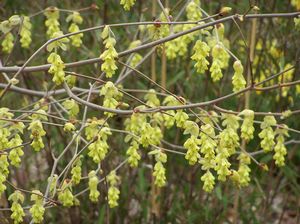Printed at http://www.quackingrassnursery.com/index.cfm/
Corylopsis sinensis var. sinensis (formerly C. willmottiae)
Willmott Winterhazel
Plant Type:
DECIDUOUS SHRUBSCorylopsis sinensis var. sinensis (formerly: C. willmottiae) – This is the Willmott Winterhazel. The fragrant primrose yellow racemes are 2” to 3” long. The medium green leaves are about 4” long sometimes attaining butter yellow tones in the fall. Multiple, gently sinuous medium gray branches make an attractive statement in winter. Though it is listed as a USDA zone 6 plant we protected it the first 3 years of its life in our garden and I’m delighted to report that it has fared very well presently for 9 years at the time of this writing. C. sinensis var. sinensis is a substantial, handsome woody shrub that isn’t very common in the trade. We’re proud to have it as part of our collection. In northern climes spring planting is highly recommended; also, winter protection is strongly recommended for 2 to 3 years until the shrub truly establishes at the far northern end of its range. Cutting grown.
Characteristics and Attributes for Corylopsis sinensis var. sinensis (formerly C. willmottiae)
Season of Interest (Flowering)
- Early Spring
Season of Interest (Foliage)
- Spring / Summer / Autumn
Interesting Bark
- Architectural
Light
- Morning Sun / Afternoon Shade
- Mostly Sunny
- Dappled Shade
Attributes
- Specimen
- Shrub Border
- Hedgerow
Growth Rate in the Garden
- Medium
Soil
- Fertile
Origins
- China
Propagated By
- Cutting Grown
Genus Overview: Corylopsis
Winterhazels. I loved seeing them in flower when visiting the Brooklyn Botanic Garden years ago when I lived in New York City. With primrose yellow racemes like a fantastical collection of dangle earrings among all branches they are a delight to behold in early spring. We have ours planted in open to part shade on a gentle slope facing the south and east with under cover of Yoshino cherries adjacent to our Daffodil Walk (with which they simultaneously bloom). Most years they flower beautifully for us getting “hit” only when we have a monster frost that occurs during the bloom cycle. Well, gardening is often an addictive form of Russian roulette! My personal feeling about these and, indeed, all genera in the Hamamelidaceae is that they are garden aristocrats – well-behaved and quietly handsome throughout the growing season, beautiful in bloom and many with good fall color. And though understated in the winter landscape they remain handsome year round… have I said too much!??
All our Winterhazels are cutting grown. Some species are easier from cutting than others. We're always likely to have, for instance, C. spicata selections but not always C. sinensis which we sometimes have trouble getting through the winter. Why? Well, we're clueless!
In northern climes spring planting is highly recommended; also, winter protection is strongly recommended for 2 to 3 years until the shrub truly establishes at the far northern end of its range.



